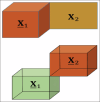Tensor Methods in Biomedical Image Analysis
- PMID: 39100745
- PMCID: PMC11296571
- DOI: 10.4103/jmss.jmss_55_23
Tensor Methods in Biomedical Image Analysis
Abstract
In the past decade, tensors have become increasingly attractive in different aspects of signal and image processing areas. The main reason is the inefficiency of matrices in representing and analyzing multimodal and multidimensional datasets. Matrices cannot preserve the multidimensional correlation of elements in higher-order datasets and this highly reduces the effectiveness of matrix-based approaches in analyzing multidimensional datasets. Besides this, tensor-based approaches have demonstrated promising performances. These together, encouraged researchers to move from matrices to tensors. Among different signal and image processing applications, analyzing biomedical signals and images is of particular importance. This is due to the need for extracting accurate information from biomedical datasets which directly affects patient's health. In addition, in many cases, several datasets have been recorded simultaneously from a patient. A common example is recording electroencephalography (EEG) and functional magnetic resonance imaging (fMRI) of a patient with schizophrenia. In such a situation, tensors seem to be among the most effective methods for the simultaneous exploitation of two (or more) datasets. Therefore, several tensor-based methods have been developed for analyzing biomedical datasets. Considering this reality, in this paper, we aim to have a comprehensive review on tensor-based methods in biomedical image analysis. The presented study and classification between different methods and applications can show the importance of tensors in biomedical image enhancement and open new ways for future studies.
Keywords: Biomedical image enhancement; tensor decomposition; tensor networks.
Copyright: © 2024 Journal of Medical Signals & Sensors.
Conflict of interest statement
There are no conflicts of interest.
Figures







References
-
- Cichocki, Andrzej, Lee, Namgil, Oseledets, Ivan, Phan, Anh-Huy, Zhao, Qibin, Mandic, Danilo P. Tensor networks for dimensionality reduction and large-scale optimization: Part 1 low-rank tensor decompositions. Foundations and Trends in Machine Learning Inc. 2016;9:249–429.
-
- Cichocki A, Mandic D, Lathauwer LD, Zhou G, Zhao Q, Caiafa C, et al. Tensor decompositions for signal processing applications: From two-way to multiway component analysis. IEEE Signal Process Mag. 2015;32:145–63.
-
- Liu J, Musialski P, Wonka P, Ye J. Tensor completion for estimating missing values in visual data. IEEE Trans Pattern Anal Mach Intell. 2013;35:208–20. - PubMed
-
- Guo X, Huang X, Zhang L, Zhang L, Plaza A, Benediktsson JA. Support tensor machines for classification of hyperspectral remote sensing imagery. IEEE Trans Geosci Remote Sens. 2016;54:3248–64.
-
- Makantasis K, Doulamis AD, Doulamis ND, Nikitakis A. Tensor-based classification models for hyperspectral data analysis. IEEE Trans Geosci Remote Sens. 2018;56:6884–98.
Publication types
LinkOut - more resources
Full Text Sources
Miscellaneous
